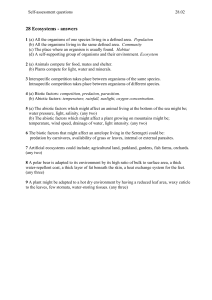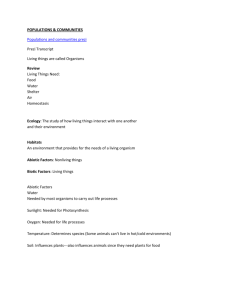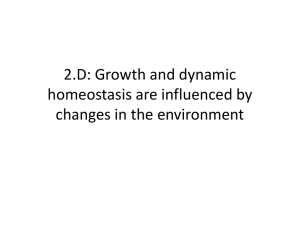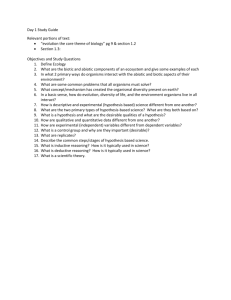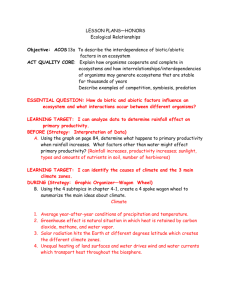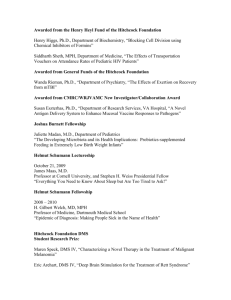doc - The Ruth Patrick Science Education Center
advertisement
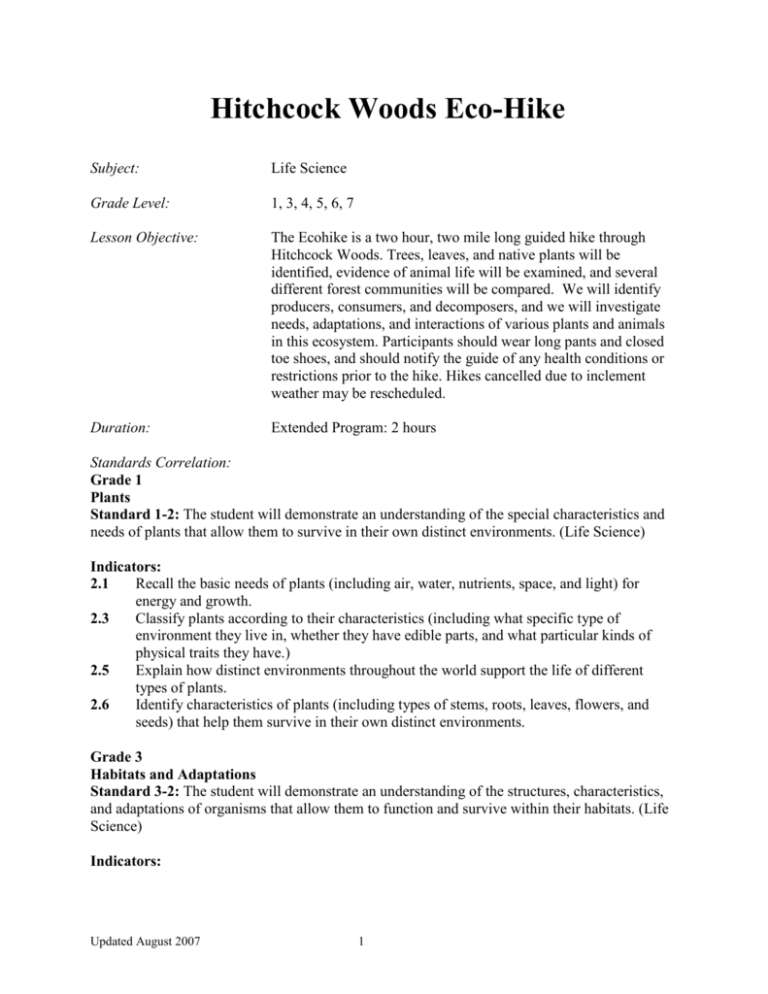
Hitchcock Woods Eco-Hike Subject: Life Science Grade Level: 1, 3, 4, 5, 6, 7 Lesson Objective: The Ecohike is a two hour, two mile long guided hike through Hitchcock Woods. Trees, leaves, and native plants will be identified, evidence of animal life will be examined, and several different forest communities will be compared. We will identify producers, consumers, and decomposers, and we will investigate needs, adaptations, and interactions of various plants and animals in this ecosystem. Participants should wear long pants and closed toe shoes, and should notify the guide of any health conditions or restrictions prior to the hike. Hikes cancelled due to inclement weather may be rescheduled. Duration: Extended Program: 2 hours Standards Correlation: Grade 1 Plants Standard 1-2: The student will demonstrate an understanding of the special characteristics and needs of plants that allow them to survive in their own distinct environments. (Life Science) Indicators: 2.1 Recall the basic needs of plants (including air, water, nutrients, space, and light) for energy and growth. 2.3 Classify plants according to their characteristics (including what specific type of environment they live in, whether they have edible parts, and what particular kinds of physical traits they have.) 2.5 Explain how distinct environments throughout the world support the life of different types of plants. 2.6 Identify characteristics of plants (including types of stems, roots, leaves, flowers, and seeds) that help them survive in their own distinct environments. Grade 3 Habitats and Adaptations Standard 3-2: The student will demonstrate an understanding of the structures, characteristics, and adaptations of organisms that allow them to function and survive within their habitats. (Life Science) Indicators: Updated August 2007 1 2.2 2.3 2.4 2.5 Explain how physical and behavioral adaptations allow organisms to survive (including hibernation, defense, locomotion, movement, food obtainment, and camouflage for animals and seed dispersal, color, and response to light for plants). Recall the characteristics of an organism’s habitat that allow the organism to survive there. Explain how changes in the habitats of plants and animals affect their survival. Summarize the organization of simple food chains (including the roles of producers, consumers, and decomposers). Grade 4 Organisms and their Environments Standard 4-2: The student will demonstrate an understanding of the characteristics and patterns of behavior that allow organisms to survive in their own distinct environments. (Life Science) Indicators: 2.2 Explain how the characteristics of distinct environments (including swamps, rivers and streams, tropical rain forests, deserts, and the polar regions) influence the variety of organisms in each. 2.5 Explain how an organism’s patterns of behavior are related to its environment (including the kinds and the number of organisms present, the availability of food and other resources, and the physical characteristics of the environment). 2.6 Explain how organisms cause changes in their environment. Grade 5 Ecosystems: Terrestrial and Aquatic Standard 5-2: The student will demonstrate an understanding of relationships among biotic and abiotic factors within terrestrial and aquatic ecosystems. (Life Science) Indicators: 2.2 Summarize the composition of an ecosystem, considering both biotic factors (including populations to the level of microorganisms and communities) and abiotic factors. 2.3 Compares the characteristics of different ecosystems (including estuaries/salt marshes, oceans, lakes and ponds, forests, and grasslands). 2.4 Identify the roles of organisms as they interact and depend on one another through food chains and food webs in an ecosystem, considering producers and consumers (herbivores, carnivores, and omnivores), decomposers (microorganisms, termites, worms, and fungi), predators and prey, and parasites and hosts. 2.5 Explain how limiting factors (including food, water, space, and shelter) affect populations in ecosystems. Grade 6 Structures, Processes, and Responses of Plants Standard 6-2: The student will demonstrate an understanding of structures, processes, and responses of plants that allow them to survivc and reproduce. (Life Science) Indicators: Updated August 2007 2 2.3 Compare the characteristic structures of various groups of plants (including vascular or nonvascular, seed or spore-producing, flowering or cone-bearing, and monocot or dicot). Structures, Processes, and Responses of Animals Standard 6-3: The student will demonstrate an understanding of structures, processes, and responses of animals that allow them to survivc and reproduce. (Life Science) Indicators: 3.1 Compare the characteristic structures of invertebrate animals (including sponges, segmeented worms, echinoderms, mollusks, and arthropds) and vertebrate animals (fish, amphibians, reptiles, birds, and mammals). 3.2 Summarize the basic functions of the structures of animals that allow them to defend themselves, to move, and to obtain resources. 3.3 Compare the response that a warm-blooded (endothermic) animal makes to a fuctuation in environmental temperature with the response that a cold blooded (ectothermic) animal makes to such a fluctuation. Grade 7 Ecology: The Biotic and Abiotic Environment Standard 7-4: The student will demonstrate an understanding of how organisms interact with and respond to the biotic and abiotic components of their environment. (Earth Science, Life Science) Indicators: 4.1 Summarize the characteristics of the levels of organization within ecosystems (including populations, communities, habitats, niches, and biomes). 4.2 Illustrate energy flow in food chains, food webs, and energy pyramids. 4.3 Explain the interaction among changes in the environment due to natural hazards (including landslides, wildfires, and floods), changes in populations, and limiting factors (including climate and the availability of food and water, space, and shelter). 4.6 Classify resources as renewable or nonrenewable and explain the implications of their depletion and the importance of conservation. Required Materials: Optional: Magnifying lenses Insect collection jars Clipboards, paper and pencils for student observations Bag for collecting leaf samples Paper and crayons for bark rubbings (for little kids) Identification guide books – plants, reptiles and amphibians, etc. Aquatic turtle or snake List of common species found in Hitchcock Woods for teacher Common leaves sheets for teacher Map of Hitchcock Woods Route for teacher Updated August 2007 3 Procedures: Meet class either at the Ruth Patrick Center, or at the entrance to Hitchcock Woods near Fulmer Stables (on Dibble Road, closest to Hitchcock Parkway). At the Hitchcock Woods parking lot, gather the group and go over the introduction and rules: Stay with the group and ON the trail We must yield to horses and riders – stop, step to the side, and stay still and quiet Do not pick leaves or berries Introduction: This is called an Eco-hike because we will be focusing on ecology. What is ecology? Have them make guesses. It is the study of not only animals and plants, but of all things living and their interactions with their nonliving environment. With an older group, you can break them into smaller groups and have each figure out what the difference is between ecology, ecosystem, community, population, and species. The following are suggestions and ideas for topics to discuss on the Hike, but it will ultimately depend on the grade level (see standards correlations listed for each grade level) as well as your own strengths and preferences. 1. Longleaf versus Loblolly pine Two types of cones on each – male (small) and female (large) Male cones drop yellow pollen in the spring, female cones develop two seeds with a wing on each pine cone scale Compare cones and needles of longleaf (cones and needles larger) vs loblolly Look at differences of young longleaf trees (grass stage) versus loblolly Talk about fire interactions – longleaf is adapted to fires more than loblolly 2. Comparing communities Upland hardwood forest Low-lying (bottomland) hardwood area Mixed pine-hardwood forest Hillside pine-mountain laurel Pond 3. Why is this area of SC called the sandhills? Why do we have sandy soil here? At one time, the ocean actually covered the lower portion of the state and the waves lapped up right by Aiken – this was literally seaside property. 4. Burned areas – why do we burn areas of Hitchcock Woods on purpose? Talk about controlled burning and how it benefits the woods. Updated August 2007 4 5. Layers of the forest Vines Herbaceous layer Small shrubs Understory trees Overstory trees 6. Decomposing logs Look for insects, fungus, amphibians, reptiles, evidence of sapsuckers (woodpeckers) Talk about producers, consumers, and decomposers 7. 8. Look for different types of spider webs and spiders Look for evidence of animals Footprints in mud Nests in trees Holes in trees or ground Feeding locations Scat 9. Leader can gather one of each type of leaf for comparison. Good examples are: Sweet gum, oak (different types), pine needle, sycamore, sassafras, magnolia, bay, etc. You can also compare bark and talk about winter identification of trees Younger students can compare crayon rubbings of different tree bark 10. You can help them identify some of the common herbaceous species using guidebooks; possibly show some of the older students how to use a dichotomous key 11. Compare moss, lichens, fungus, ferns 12. By the pond: Look for turtles, snakes, lizards, frogs and toads There are wood duck boxes by the back edges of the Black Gum Pond 13. Listen for bird calls and have them try to figure out how many different birds they heard during the hike. Updated August 2007 5

